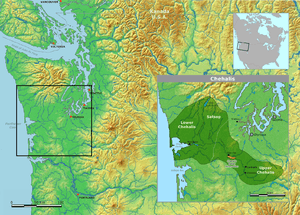Chehalis people

The Chehalis people are a native people of western Washington state in the United States. Today some are enrolled in the federally recognized Confederated Tribes of the Chehalis Reservation and the Quinault Tribe of the Quinault Reservation. They should not be confused with the similarly named Chehalis First Nation of the Sts'Ailes people along the Harrison River in the Fraser Valley area of British Columbia.
The Chehalis of Washington consists of two divisions: The Upper Chehalis and the Lower Chehalis. Within these were several tribes: the Copalis, Wynoochee and Humptulips people were part of the Lower Chehalis, while the Satsop people were part of the Upper Chehalis. The boundary between the two groups was the confluence of the Chehalis River and Satsop River.
Like many Northwest Coast natives, the Chehalis relied on fishing from local rivers for food and built plank houses (longhouses) to protect themselves from the harsh, wet winters west of the Cascade Mountains.
Language
The Lower and Upper Chehalis languages belong to the Coast Salish family of languages among Northwest Coast indigenous peoples.
Reservation
The Chehalis people settled on their current Chehalis Indian Reservation (46°49′04″N 123°11′42″W / 46.81778°N 123.19500°W) along the Chehalis River in 1860. The reservation has a land area of 18.188 km² (7.022 sq mi) in southeastern Grays Harbor and southwestern Thurston Counties. As of the 2000 census its resident population was 691 persons. The major communities within the reservation are Chehalis Village and part of the city of Oakville. In the 2010 census, the population increased to 853 members. 639 of them were full-blooded.[1]
References
- ↑ "2010 Census CPH-T-6. American Indian and Alaska Native Tribes in the United States and Puerto Rico: 2010" (PDF). www.census.gov. Retrieved 2015. Check date values in:
|access-date=(help)
- Chehalis Reservation, Washington United States Census Bureau
External links
- Confederated Tribes of the Chehalis, official website